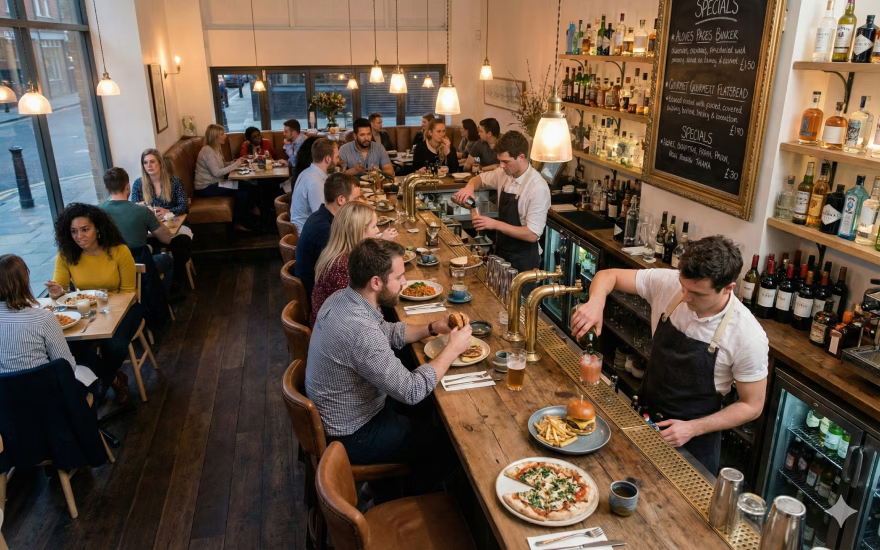How to Build the Ultimate Restaurant Opening Checklist (With Expert Tips)

Opening a restaurant each day isn’t just about unlocking the doors and turning on the lights — it’s about setting the tone for the entire day. A well-structured restaurant opening checklist plays a critical role in ensuring that every shift starts strong, staff are aligned, and guests receive the best experience from the moment they walk in. But what should be on that checklist, and how can restaurant leaders implement it effectively? This guide breaks it all down, complete with insights, expert techniques, and digital tools that bring order to the back and front of the house.
Whether managing one location or several, restaurant leaders can use this guide to create an actionable, role-based checklist that boosts morale, minimizes errors, and increases revenue. Let’s explore how a small daily routine — when handled right — can have a big impact.
What Is a Restaurant Opening Checklist and Why Do You Need One?
A restaurant opening checklist is a standardized list of tasks staff must complete before service begins each day. It includes everything from equipment checks and food prep to dining area setup and administrative duties. The checklist ensures consistency, accountability, and readiness across departments — from the front-of-house (FOH) to the back-of-house (BOH).
Without one, shift openings can quickly spiral into chaos. Tasks may be forgotten, equipment might go unchecked, and guests could arrive to an unprepared dining room. Not only does this hurt the guest experience, but it also creates unnecessary stress for staff and managers.
A well-executed opening checklist delivers measurable benefits:
- Smoother shift transitions
- Reduced onboarding time for new hires
- Compliance with safety and food handling regulations
- Stronger team accountability
- A better first impression for every guest
What Should Be on a Daily Restaurant Opening Checklist?
An effective restaurant opening checklist should be customized to your location’s operations and team structure. However, most restaurants benefit from breaking tasks into three primary categories: FOH, BOH, and managerial/admin responsibilities.
The checklist should align with the natural flow of service preparation, beginning at clock-in and ending just before guests are welcomed in. Here’s how to structure yours.
FOH Opening Tasks to Include
- Turn on lights, music, and televisions
- Set and sanitize tables according to daily cover expectations
- Inspect restrooms for cleanliness, supplies, and lighting
- Check menus for cleanliness and accuracy
- Run a test transaction on the POS system
- Confirm reservation list and special event setups
BOH Opening Tasks to Include
- Perform equipment and refrigeration temperature checks
- Review prep list and begin mise en place
- Sanitize prep surfaces and sinks
- Confirm deliveries and update inventory as required
- Post kitchen communication notes or updates
Managerial and Admin Tasks
- Review the manager’s logbook from the prior day
- Set up cash drawers and safe counts
- Analyze labor reports and daily staffing levels
- Conduct a pre-shift huddle and communicate team goals
This structure gives workers clear direction and helps each team member understand their role in a successful open.
How Can a Restaurant Opening Checklist Improve Operations?
Routine is the backbone of successful restaurant operations. When staff begin their shift with a clear framework, it reduces guesswork and enhances role clarity. Checklists also empower employees, reduce errors, and help flag issues before they disrupt service.
Beyond the frontlines, a checklist improves labor efficiency and makes training easier for new hires. Instead of relying on verbal instructions or shadowing, new team members have a clear, consistent guide.
How Do You Customize a Restaurant Opening Checklist for Your Concept?
Not all restaurants are created equal. A quick-service café has very different opening needs from a fine-dining steakhouse. Customizing the checklist to your concept ensures tasks are relevant and the workflow suits your pace and service model.
Consider these factors when building your opening checklist:
- Type of service: QSR, full-service, bar, café
- Menu complexity and prep times
- Staffing levels and role definitions
- Seasonal changes (e.g., patio seating setup in summer)
- Multi-unit standardization vs. independent flexibility
For multi-location brands, checklists offer a way to standardize expectations across units while still allowing location-specific customizations.
What Tools Can Help Automate and Track Daily Opening Checklists?
Traditional checklists — often scribbled on clipboards or laminated sheets — can’t scale with operational demands. They’re prone to being ignored, incomplete, or lost. Modern restaurants need a smarter solution.
By digitizing your opening checklist, teams gain:
- Mobile access to daily opening tasks
- Real-time tracking of checklist completion
- Alerts for missed or overdue steps
- Integration with time-tracking and labor compliance tools
How Do Pre-Shift Meetings Fit Into the Opening Process?
A successful opening isn’t just about tasks — it’s about team alignment. Pre-shift meetings are an essential part of the opening checklist, offering a chance to set the tone, drive motivation, and deliver key updates.
Effective pre-shift huddles are brief, focused, and energizing. These structured touchpoints allow managers to share critical information and encourage staff performance.
Pre-Shift Meeting Checklist Ideas
- Highlight reservations and VIP guests
- Detail daily specials, 86’d items, and menu notes
- Share team or location goals (e.g., sales targets, upsell reminders)
- Recognize outstanding performance from previous shifts
How Do You Train Staff to Follow an Opening Checklist?
Even the best checklist is useless if no one follows it. Training is critical to adoption. Build it into your onboarding protocols so that new hires understand what's expected from day one.
Here’s how to make it stick:
- Ensure checklists are included in orientation
- Assign tasks by role
- Provide coaching and reminders to staff who have a tendency to forget their tasks
- Require staff to acknowledge task completion
- Acknowledge and reward team members who complete their opening tasks the faster
What Are Common Mistakes to Avoid When Creating an Opening Checklist?
Creating an effective opening checklist requires balance — not all tasks are equal, and not every list should be a novel. Watch for these common mistakes:
- Making the checklist too long or vague
- Forgetting to assign clear task ownership
- Using outdated processes that no longer reflect operations
- Ignoring feedback from staff who actually use the list
- Lack of follow-through or accountability
Can Opening Checklists Impact Guest Experience and Revenue?
Absolutely. The guest experience starts well before a customer sits down. If the lighting is off, the restroom isn’t stocked, or the staff is flustered — these signals hurt perception. According to a Zagat survey, 80% of diners said cleanliness plays a major role in their decision to return to a restaurant.
Opening checklists tie together FOH hospitality and BOH readiness. From a spotless entrance to accurately prepped ingredients, checklists ensure positive first impressions, fewer mid-shift disruptions, and higher average ticket sales. When everything’s in order, guests feel confident — and that confidence often translates into loyalty and return visits.
Conclusion: Start Every Shift Strong With a Restaurant Opening Checklist
For restaurant leaders, a solid opening checklist is more than a routine — it’s a roadmap to smoother operations, empowered teams, and better guest experiences. From prep stations to pre-shift meetings, each task builds momentum for a successful day. Your guests will notice and your team will appreciate the organization that a checklist brings. By dividing your restaurant's opening checklist into three department-based segments, introducing them during onboarding, and gaining feedback from your team on how to best utilize the checklists, you can make every opening shift as smooth as butter.
Ready to simplify your restaurant's workforce management?
Push Operations helps you automate payroll, scheduling, and time tracking — all in one platform designed for the unique challenges of the restaurant industry. Book a demo today and see how Push can transform your back office.



